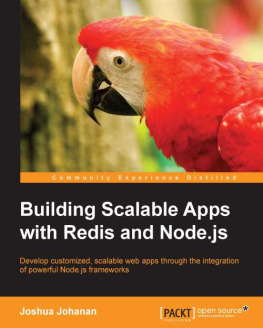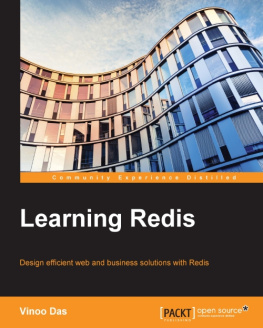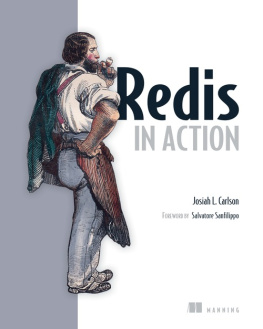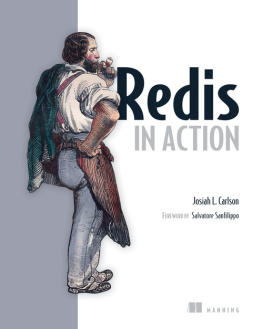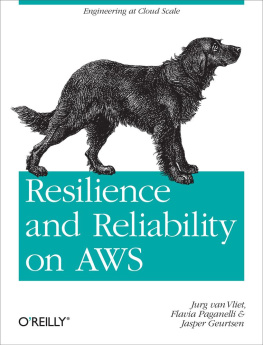James Smith - Build Your Own Redis with C/C++
Here you can read online James Smith - Build Your Own Redis with C/C++ full text of the book (entire story) in english for free. Download pdf and epub, get meaning, cover and reviews about this ebook. year: 2023, genre: Home and family. Description of the work, (preface) as well as reviews are available. Best literature library LitArk.com created for fans of good reading and offers a wide selection of genres:
Romance novel
Science fiction
Adventure
Detective
Science
History
Home and family
Prose
Art
Politics
Computer
Non-fiction
Religion
Business
Children
Humor
Choose a favorite category and find really read worthwhile books. Enjoy immersion in the world of imagination, feel the emotions of the characters or learn something new for yourself, make an fascinating discovery.
- Book:Build Your Own Redis with C/C++
- Author:
- Genre:
- Year:2023
- Rating:3 / 5
- Favourites:Add to favourites
- Your mark:
- 60
- 1
- 2
- 3
- 4
- 5
Build Your Own Redis with C/C++: summary, description and annotation
We offer to read an annotation, description, summary or preface (depends on what the author of the book "Build Your Own Redis with C/C++" wrote himself). If you haven't found the necessary information about the book — write in the comments, we will try to find it.
Build Your Own Redis with C/C++ — read online for free the complete book (whole text) full work
Below is the text of the book, divided by pages. System saving the place of the last page read, allows you to conveniently read the book "Build Your Own Redis with C/C++" online for free, without having to search again every time where you left off. Put a bookmark, and you can go to the page where you finished reading at any time.
Font size:
Interval:
Bookmark:
Learn network programming and data structures
James Smith
2023-01-31
This book contains a step-by-step walkthrough of a simple implementation of a Redis-like server. It is intended as a practical guide or tutorial to network programming and the implementation and application of basic data structures in C.
Redis could be considered one of the building blocks of modern computing that stood the test of time. The knowledge required for building such a project is broader and deeper than usual application-level development. Learning from such projects is a good way for software developers to level up their skills.
Redis is a good target for learning because it covers two important subjects of software engineering: network programming and data structures.
- While there are many guides on socket APIs or high-level libraries, network programming is more than calling APIs or libraries. It is important to understand core concepts such as the event loop, protocols, timers, etc, which this book will cover. The lack of understanding can result in fatal mistakes even if you are just employing high-level networking libraries or frameworks in your applications.
- Although many people learned some basic data structures from textbooks, there is still something more to learn. Data structures implemented in real projects often have some practical considerations which are not touched by textbooks. Learning how data structures are used in a non-toy environment (especially in C) is a unique experience from building Redis.
Like most real-world projects, Redis is a complex project built with lots of effort, which can be hard to grasp for beginners. Instead, this book takes an opposite approach: learning by building things from scratch.
A couple of points:
- To learn faster. By building things from scratch, concepts can be introduced gradually. Starting from the small, adding things incrementally, and getting the big picture in the end.
- To learn deeper. While there are many materials explaining how an existing stuff works, the understanding obtained by reading those materials is often not the same as building the stuff yourself. It is easy to mistake memorization for understanding, and its easier to pick up unimportant details than principles and basics.
- To learn more. The from scratch approach forces you to touch every aspect of the subject there are no shortcuts to knowledge! And often not every aspect is known to you beforehand, you may discover things I dont know I dont know in the process.
Summarized in a quote from Feynman: What I cannot create, I do not understand.
This book follows a step-by-step approach. Each step builds on the previous one, adding a new concept. The full source code is provided on the web for reference purposes, readers are advised to tinker with it or DIY without it.
The code is written as direct and straightforwardly as the author could. Its mostly plain C with minimal C++ features. Dont worry if you dont know C, you just have the opportunity to do it in another language by yourself.
The end result is a mini Redis alike with only about 1200 lines of code. 1200 LoC seems low, but it illustrates many important aspects the book attempts to cover.
The techniques and approaches used in the book are not exactly the same as the real Redis. Some are intentionally simplified, and some are chosen to illustrate a general topic. Readers can learn even more by comparing different approaches.
The code used in this book is intended to run on Linux only, and can be downloaded at this URL:
https://build-your-own.org/redis/src.tgz
The contents and the source code of this book can be browsed online at:
https://build-your-own.org
This chapter is an introduction to socket programming. Readers are assumed to have basic knowledge of computer networking but no experience in network programming. This book does not contain every detail on how to use socket APIs, you are advised to read manpages and other network programming guides while learning from this book. (https://beej.us/ is a good source for socket APIs.)
Redis is an example of the server/client system. Multiple clients connect to a single server, and the server receives requests from TCP connections and sends responses back. There are several Linux system calls we need to learn before we can start socket programming.
The socket() syscall returns an fd. Here is a rough explanation of fd if you are unfamiliar with Unix systems: An fd is an integer that refers to something in the Linux kernel, like a TCP connection, a disk file, a listening port, or some other resources, etc.
The bind() and listen() syscall: the bind() associates an address to a socket fd, and the listen() enables us to accept connections to that address.
The accept() takes a listening fd, when a client makes a connection to the listening address, the accept() returns an fd that represents the connection socket. Here is the pseudo-code that explains the typical workflow of a server:
close(conn_fd)The read() syscall receives data from a TCP connection. The write() syscall sends data. The close() syscall destroys the resource referred by the fd and recycles the fd number.
We have introduced the syscalls needed for server-side network programming. For the client side, the connect() syscall takes a socket fd and address and makes a TCP connection to that address. Here is the pseudo-code for the client:
close(fd)The next chapter will help you get started using real code.
This chapter continues the introduction of socket programming. Well write 2 simple (incomplete and broken) programs to demonstrate the syscalls from the last chapter. The first program is a server, it accepts connections from clients, reads a single message, and writes a single reply. The second program is a client, it connects to the server, writes a single message, and reads a single reply. Lets start with the server first.
First, we need to obtain a socket fd: int fd = socket(AF_INET, SOCK_STREAM, 0);
The AF_INET is for IPv4, use AF_INET6 for IPv6 or dual-stack socket. For simplicity, well just use AF_INET throughout this book.
The SOCK_STREAM is for TCP. We wont use anything other than TCP in this book. All the 3 parameters of the socket() call are fixed in this book.
Next, well introduce a new syscall:
setsockopt ( fd , SOL_SOCKET , SO_REUSEADDR , & val , sizeof ( val ));The setsockopt() call is used to configure various aspects of a socket. This particular call enables the SO_REUSEADDR option. Without this option, the server wont able to bind to the same address if restarted. Exercise to reader: find out what exactly is SO_REUSEADDR and why it is needed.
The next step is the bind() and listen(), well bind on the wildcard address 0.0.0.0:1234:
}Loop for each connection and do something with them.
}Font size:
Interval:
Bookmark:
Similar books «Build Your Own Redis with C/C++»
Look at similar books to Build Your Own Redis with C/C++. We have selected literature similar in name and meaning in the hope of providing readers with more options to find new, interesting, not yet read works.
Discussion, reviews of the book Build Your Own Redis with C/C++ and just readers' own opinions. Leave your comments, write what you think about the work, its meaning or the main characters. Specify what exactly you liked and what you didn't like, and why you think so.









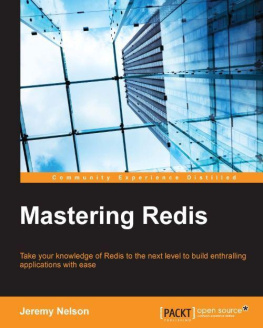
![Macedo - Redis cookbook: [Practical techniques for fast data manipulation]](/uploads/posts/book/137932/thumbs/macedo-redis-cookbook-practical-techniques-for.jpg)
